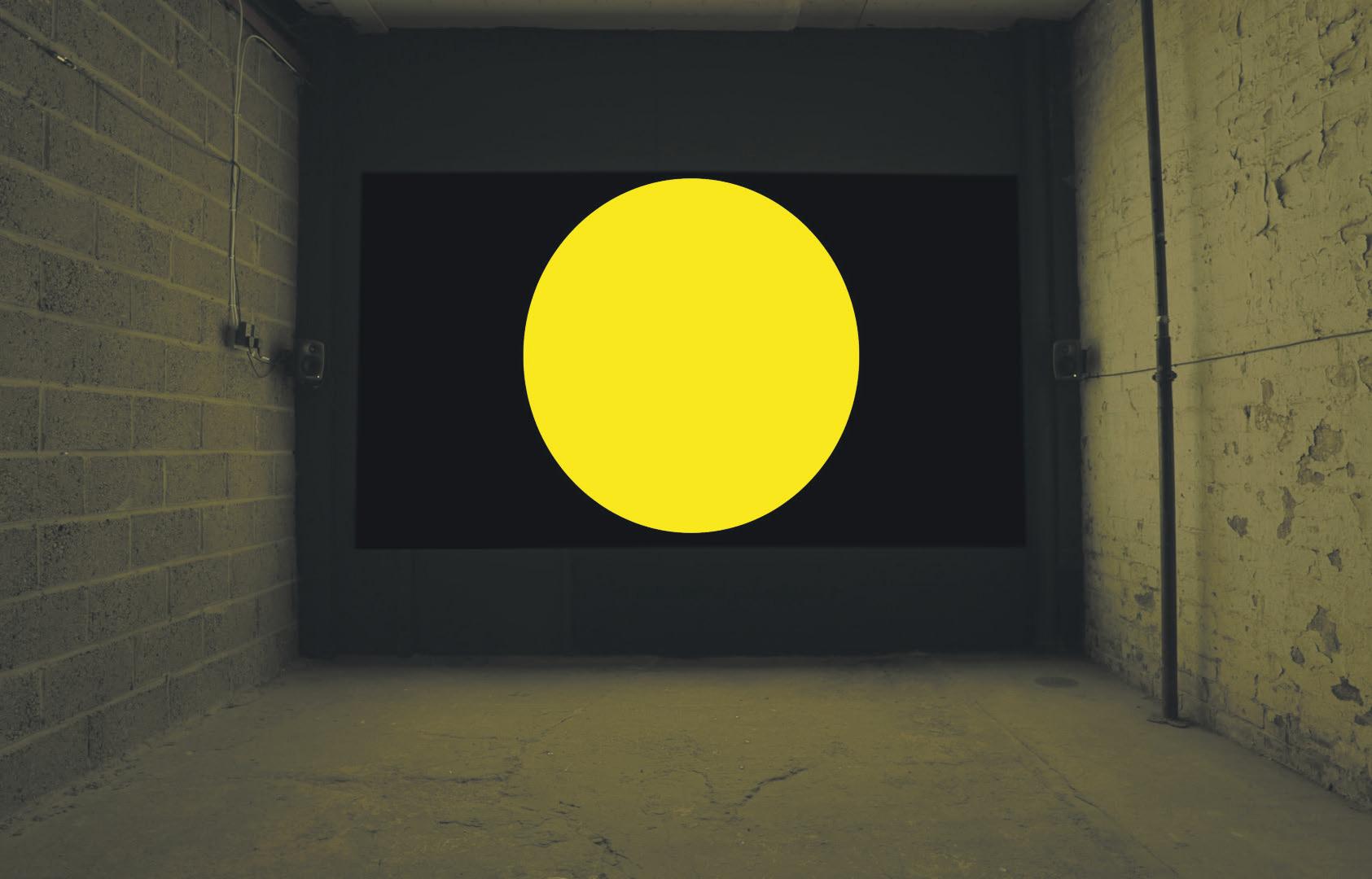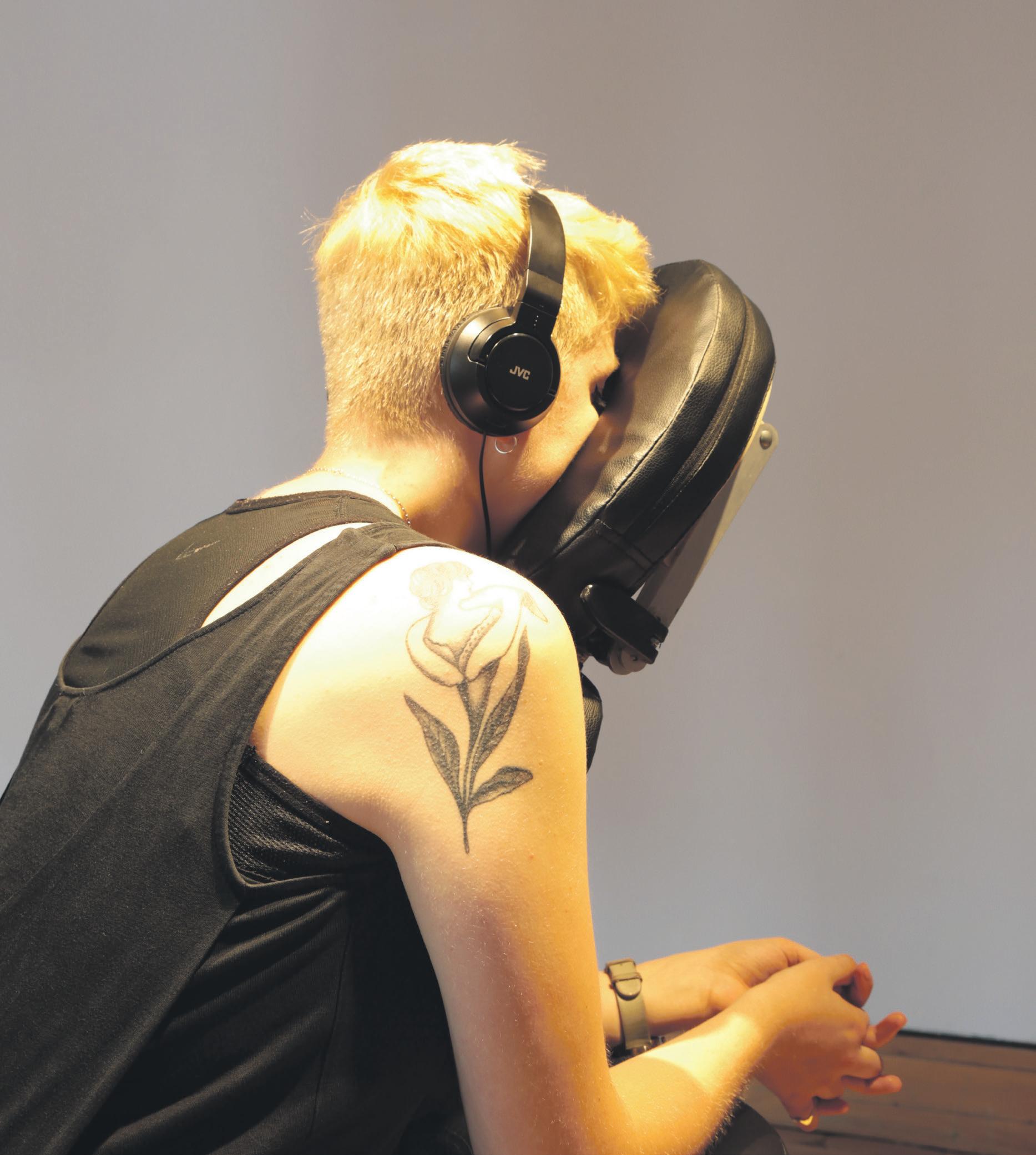
6 minute read
Teenage Fanboy. Gwen Burlington discusses the work of Irish artist
Renèe Helèna Browne, Sacred Disease, 2019, HD video, installation view; image courtesy the artist.
Teenage Fanboy
GWEN BURLINGTON DISCUSSES THE WORK OF IRISH ARTIST RENÈE HELÈNA BROWNE.
RENÈE HELÈNA BROWNE is a self-described ‘teenage fanboy’. The diverse modes of their practice – which include writing, sound, film and sculpture, often taking an autobiographical approach – are underpinned by fandom as a means of constructing identity. Rooted in writing, their work is also about language and how gender and class are inherently inscribed in the sounds we utter. Originally from Donegal and currently based in Glasgow, Browne has a research-based practice with many institutional ties, having just been announced as Talbot Rice Resident Artist with Edinburgh College of Art at the University of Edinburgh, and having also been a Research Associate with the Centre for Contemporary Art Derry~Londonderry last year. In recent work, Browne adeptly mobilises text, image and sound to create montages that persistently reflect on ideas of trans embodiment, masculinity and voice.
Browne’s video essays combine a broad range of filmic devices, creating multi-layered narratives. A recent moving-image work, Daddy’s Boy (2020) – shown at Berwick Film and Media Festival and aemi screenings – explores ideas of hegemonic masculinity through collaged video footage of Browne’s father, who goes about his business on the family farm with a bland acquiescence to the camera’s gaze. Part recorded during lockdown in rural Donegal and part assembled from a larger archive Browne had unconsciously been building over time, the film is layered with the artist’s lyrical voiceover, describing their fascination with the popular film classic, Jurassic Park, and in particular, the T-Rex.
Throughout the film, Browne’s fandom operates as a means of self-critique. Browne’s queer identification with and adoration of the monstrous creature of T-Rex is a vehicle through which the artist is able to reflect upon and perform their own (conflicted) gender identity and learned masculinity. As Browne moulds a T-Rex into form with pink and orange plasticine, the object of desire is identified and possessed through this act of moulding. Combined with the footage of Browne’s father – a manifestation of their desire to be the archetypal lone, self-sufficient, unquestioned male – fandom becomes a way into trans identification, presenting the
viewer with a portrayal of a desired mode of behaviour; a masculinity that is innate and non-performative. Jealousy, desire and idolisation operate at a level where these impulses collapse into one another, creating a collage of trans embodiment.
The use of popular film, music and television references as a means to construct identity is used throughout the artist’s practice, not as an act of homage but deconstruction. In Sacred Disease (2019), a video essay shown as part of Browne’s MFA degree show in Glasgow, the artist describes and breaks down a scene from the 90s series, Sex and the City, in which the character Samantha gorges on a cookie that says, ‘I love you’, making herself ill. In conversation over Zoom from Glasgow, Browne confides: “I really feel so deeply affected by fiction. I’m really interested in how it operates, the visual mechanics of it and breaking those things down.” Making work around the subjects they’re enamoured with is a means of being close to the objects of desire that Browne can’t access. “Fiction can do so much more than laborious, heavy cold theory and has its own voice.”
In A Wall or Bridge Disappears Abruptly at the Hinge (2019), Browne utilises fandom as a way of reworking canonised icons, histories and objects to reveal what might be missing in more conventional approaches. In a text, written about, to and with Eileen Gray and her work Le Destin, a four-panel lacquered screen, Browne mines the images of the work and its maker. Throughout the text, written towards the end of their MFA, a close look at the artwork is interwoven with personal narratives and tangential musings, not unlike TJ Clark’s book, The sight of Death: An Experiment in Art Writing, published in 2006, which Browne cites as a reference point. In conversation, Browne explains how they were writing through feeling, rather than writing through some pre-structured thoughts: “I found it helpful to do that through an artwork that already exists in the world, in an attempt to build a subjective viewpoint on something that’s sitting in front of you.”
This loose and experimental approach to form is also seen in earlier work, such as Four Scores for the Ear (2018) – a vocal soundscape experiment, aired on Dublin Digital Radio for ‘Sound in Exile’, a curated programme by Jane Deasy. Here we see Browne’s interest in voice surface through abstracted sonic communication – repetition, singing, chanting. Love Song to Drake (2018) mines similar territory, an ode to the hip-hop artist, where Browne sings and riffs off the lyrics and style in an act of fandom, similar to “drawing pictures of Amy Winehouse as a teenager.” Browne describes it as a paradoxical act of ‘crush and criticism’ in being a fan of Drake and his “clever use of lyrics”, while also resisting the identifications expressed in those lyrics, in particular his ‘martyrdom’.
With identity formation a common theme in their practice, it is not surprising that Browne is interested in accent – a tie to one’s identity, similar to race and gender. The power relations and hierarchies of voice and accent are more thoroughly explored in Deboned Voices, a five-part audio installation of disembodied voices with corresponding seating, shown as part of the Edinburgh Art Festival in 2018. Each sound piece had a chair chosen specifically for its sonic counterpart. ‘The Queen’s English’ was aptly listened to through headphones, in a posture-correcting chair. To Irish ears, this is imbued with a comical pomposity and overt poshness that perhaps to British listeners might attenuate to a mere accepted authorial voice. This section was juxtaposed with the ASMR-esque ‘The Lips Admission’, listened to while sat in a luxurious chaise longue and which talks sensuously in headphones about being ‘licked and bitten’. The artwork subtly explored sonic tropes and the ways in which gender, class and sexuality can be constructed and reinforced within the sounds we make, coherent or not.
As described by Joli Jenson, being a fan is “explored in relation to the larger question of what it means to desire, cherish, seek, long, admire, envy, celebrate, protect, ally with others. Fandom is an aspect of how we make sense of the world, in relation to mass media, and in relation to our historical, social, cultural location.” Browne performs identifications with and appropriations of their objects of fascination, often through a mode of gender deviance and transgression. The artist’s love for and adolescent ‘crush’ on artists, celebrities, films and objects, in this sense, serves as a medium for constructing identity that transcends traditional understandings and limitations of class or gender. Their recent work operates between real and fictional worlds, where the inner depths of emotional life are brought to the surface and are unravelled for the viewer, questioning what it means to be in a body within the world.
Gwen Burlington is a writer based between Wexford and London.

Renèe Helèna Browne, Deboned Voices, 2018, five-part audio installation commissioned by Edinburgh Art Festival for Platform; image courtesy the artist.











